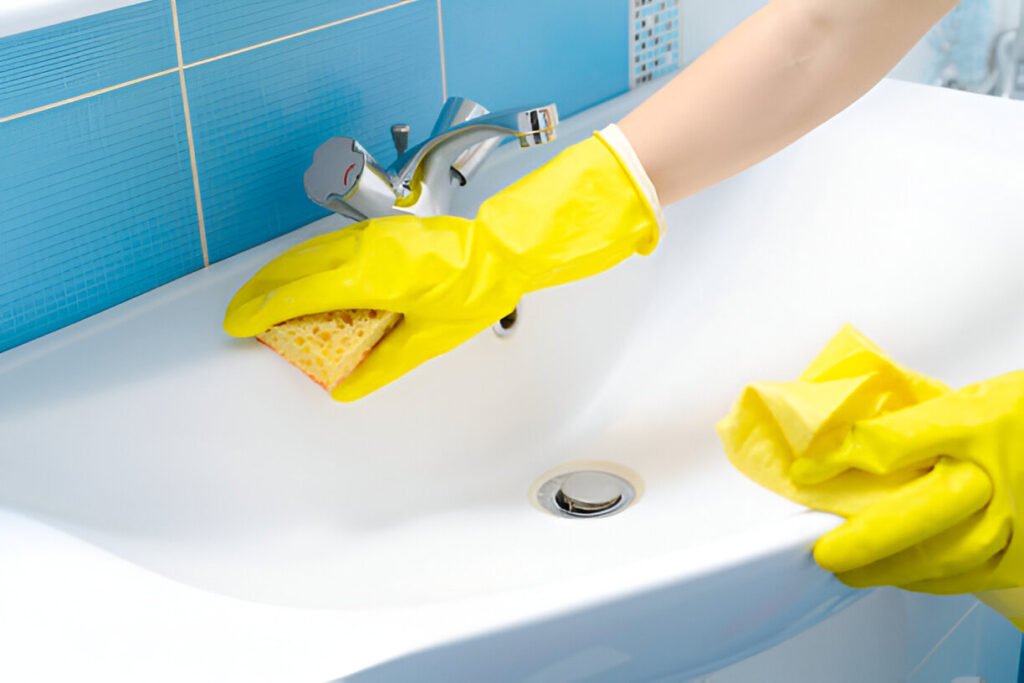Getting Started with Bathroom Cleaning
Begin your bathroom cleaning by setting up your space for success. This involves organizing your bathroom and gathering all the cleaning products and tools like rubber gloves and a cleaning caddy to make the process efficient.
Organizing and Decluttering
Start by clearing out any clutter. Check your bathroom counters and shelves, and remove items you don’t use daily. Store them in cabinets or drawers to keep surfaces clear. Throw away expired or empty products to free up space.
Consider using storage bins or baskets to group similar items together. For instance, keep all your hair products in one bin and skincare products in another. This step helps create a more manageable space, making cleaning easier.
Gathering Your Cleaning Supplies
Before you begin cleaning, make sure you have everything you need. Gather essential supplies such as rubber gloves, microfiber cloths, a sponge, a toilet brush, and a disinfectant. Prepare a cleaning caddy to keep these items organized and easy to carry around.
Using common household items like vinegar and baking soda can be a great addition to your cleaning arsenal. These can tackle tough stains and leaves surfaces sparkling. With everything ready, you’ll find the cleaning process smoother and more enjoyable.
Dusting and Vacuuming
Cleaning your bathroom involves getting rid of dust on surfaces and vacuuming the floor thoroughly. This keeps your bathroom looking tidy and helps maintain a healthy environment.
Removing Dust From Surfaces
Begin by tackling the dust on high surfaces like shelves and light fixtures. Using a dry microfiber cloth helps pick up dust without spreading it around.
Don’t forget to clean other surfaces such as countertops and the top edges of bathroom cabinets. It’s handy to use a small brush for tight spots. Consider starting from the highest points like moldings and working downwards. This ensures you’re catching all the dust and prevents any from settling back on already cleaned areas.
Vacuuming Floors and Mats
Vacuuming involves more than just cleaning the floor. Begin by removing bath mats. Shake them outside to get rid of loose dust and dirt. Then, use a vacuum with a hose attachment to reach tight corners and edges.
Pay special attention to dust and debris near the baseboards. Running the vacuum over the entire floor ensures you capture everything. Replace the mats once the floor is clean. If needed, use a mop afterward for an extra-clean finish, especially if your floor needs it.
Deep Cleaning the Bathroom
When deep cleaning your bathroom, focus on areas prone to grime like the toilet, tub, shower, countertops, and sink. It’s important to use effective cleaners and tools to tackle each part. Here’s how you can handle these critical areas with ease.
Tackling the Toilet
Begin with the toilet, a key player in bathroom hygiene. Use a good toilet bowl cleaner to cover the inside of the bowl. Let it sit for about 10 minutes to dissolve stains and germs.
Use a toilet brush to scrub inside thoroughly, reaching under the rim. For the outer parts, use a disinfecting wipe to clean the lid, tank, and base. Don’t forget the handles—they often harbor bacteria.
Scrubbing the Tub and Shower
The tub and shower can accumulate soap scum, mold, and mildew. Use a mixture of baking soda and vinegar or a store-bought cleaner. Apply to the tub surface and scrub with a sponge or old toothbrush—great for grout and corners.
If you have shower doors, vinegar can cut through limescale. Spray, let sit for a few minutes, then wipe clean. Remove mildew growth with a dedicated mildew cleaner or bleach solution.
Attacking Bathroom Countertops and Sink
Clear the bathroom countertops of all items first. Spray a multi-surface cleaner on the surfaces, leaving it on for a few minutes to break down dirt. Wipe clean with a cloth or sponge.
Focus on the sink and faucet handles, where limescale builds up. Use vinegar or a limescale remover to make them sparkle. For an added touch, buff surfaces dry to prevent water spots.
Focus on Floors and Grout
Keeping the floors and grout clean is key to a sparkling bathroom. This section will guide you through effective methods to clean each thoroughly.
Cleaning the Bathroom Floor
Start by sweeping or vacuuming to pick up loose dirt and dust. Use a microfiber mop and a gentle floor cleaner to wash the surface. A mixture of water and vinegar can work on most tiles but avoid using this on natural stone as it might damage the surface.
Mop in small sections and change the water often to prevent spreading dirt. Scrub any stuck-on grime with a soft-bristled brush. Regular maintenance helps prevent nasty buildup and keeps your floors shining longer.
Refreshing Tile Grout
Grout can get dingy quickly, but a few simple steps can restore it. Mix a paste of baking soda and water, then scrub it into the grout lines using a grout brush or an old toothbrush. Let it sit for 5-10 minutes.
Next, spray white vinegar over the paste. The mild fizz helps lift stains. Wipe the area clean with a damp cloth after the fizzing stops. If the grout still looks dull, try applying hydrogen peroxide with a brush and rinse well with water.
Maintaining your grout regularly will keep it looking fresh and prevent deep stains from setting in.
Sanitizing and Polishing Details
Keeping your bathroom spotless involves focusing on key areas that often get overlooked. These include mirrors, metal fixtures, and surfaces you frequently touch. Each needs special attention to ensure they are both clean and shining.
Mirrors and Glass Surfaces
To keep your mirrors and glass surfaces crystal clear, start by wiping them down with a microfiber cloth. This helps prevent streaks. Apply a glass cleaner sparingly, spraying it directly onto a clean cloth or sponge instead of the glass itself to avoid drips. Make broad, even strokes across the mirror.
For stubborn spots, a bit of vinegar on the cloth can do wonders. It cuts through grime and leaves surfaces spotless. If your shower curtain has glass components, use the same method to make them sparkle. Regular polishing keeps things looking pristine and enhances the feel of a clean bathroom.
Faucets and Metal Fixtures
Your faucets and metal fixtures require care to maintain their shine. First, remove any dry residue or water spots using a wet cloth. A solution of equal parts vinegar and water also works wonders on limescale.
After cleaning, dry with a soft cloth to prevent new watermarks. For an extra shine, polish the faucet hardware with a bit of baby oil applied to a cloth. This not only makes them gleam but also helps resist fingerprints. Be gentle to avoid scratching the metal.
Touch-Up on Frequently Touched Surfaces
Frequently touched surfaces in the bathroom include light switches, handles, and doorknobs. These can harbor germs if left uncleaned. Wipe them down with a disinfecting wipe or a cloth dampened with a sanitizing solution.
Be sure to cover all high-use areas, including the toilet flush handle and shower knobs. Using a rubber band to secure a cloth over a broom handle can make reaching high spots simpler. A regular routine for these touch-ups keeps your bathroom safe and hygienic for everyone.
Maintaining a Fresh and Healthy Bathroom
Keeping your bathroom fresh and healthy involves managing moisture and setting up regular cleaning habits. It’s important to focus on proper ventilation and sticking to a cleaning schedule to reduce germs and bacteria.
Regulating Humidity and Ventilation
Humidity can lead to mold and mildew, so it’s crucial to maintain proper ventilation. Use a bathroom fan every time you shower and leave it on for about 15-20 minutes afterward. This helps clear out moisture and prevent dampness.
Make sure the bathroom vent is clean and functioning well. Dust and debris can block airflow. Open windows when you can to improve circulation, especially on nice days. A well-ventilated bathroom stays fresher and reduces musty odors.
Establishing a Cleaning Schedule
Setting up a regular cleaning schedule is key for a sanitary bathroom. Clean surfaces at least once a week using a good disinfectant. Pay attention to spots that gather germs, like the toilet, sink, and doorknobs.
Use a pumice stone for tough stains on toilet bowls, but be gentle to avoid scratches. It’s also helpful to occasionally wipe down your bathroom with a microfiber cloth to keep germs and bacteria at bay. By sticking to your cleaning routine, your bathroom stays healthier and cleaner.



